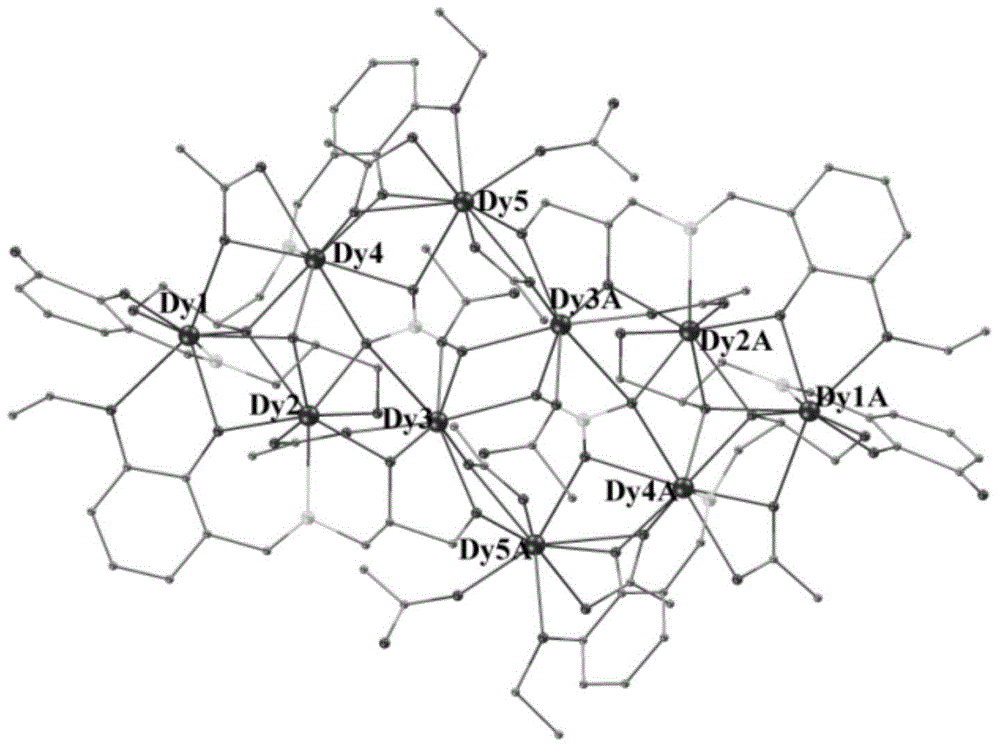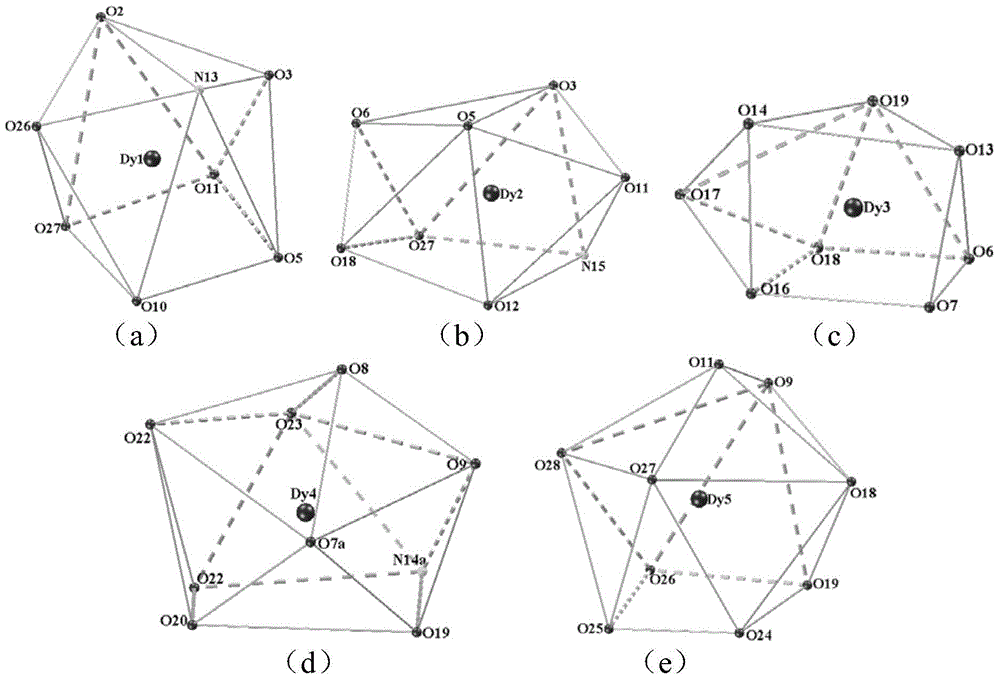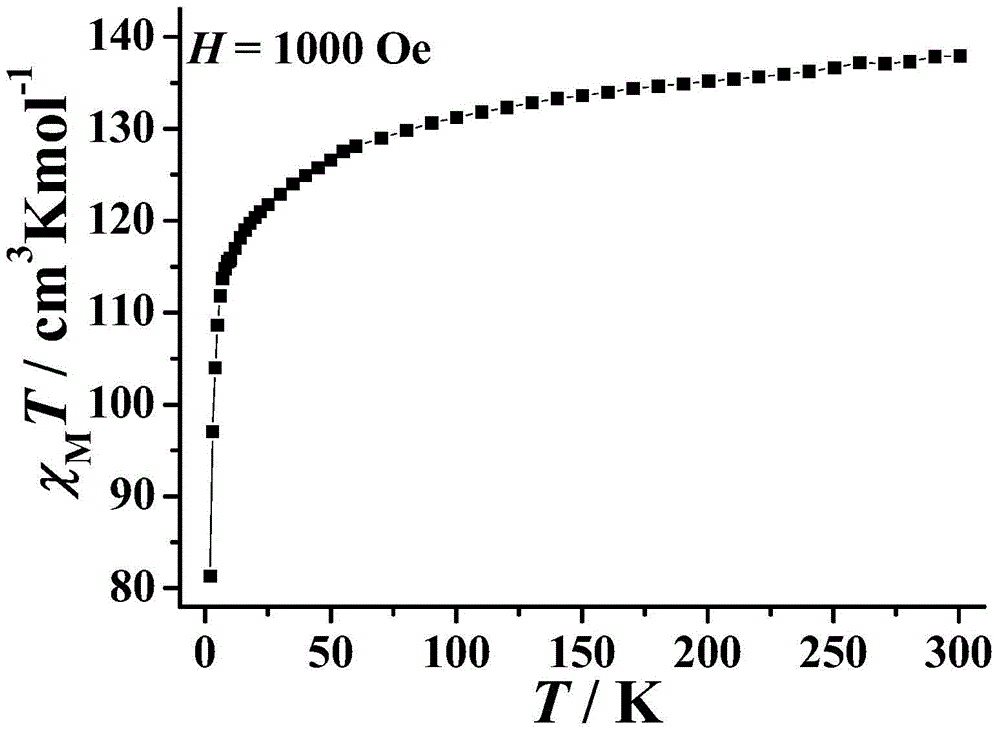Rare earth based molecular magnet constructed by taking alkylol amine Schiff base generated in situ as ligand and preparation method of rare earth based molecular magnet
A technology of alkanolamine Schiff base and molecular magnet, which is applied in chemical instruments and methods, inductance/transformer/magnet manufacturing, organic material/organic magnetic material magnetism, etc., can solve the problem that there are not many rare earth-based molecular magnets, and achieve Low cost of raw materials, high yield and good repeatability
- Summary
- Abstract
- Description
- Claims
- Application Information
AI Technical Summary
Problems solved by technology
Method used
Image
Examples
Embodiment 1
[0032] The rare earth-based molecular magnet [Dy 10 (L) 4 (HL) 2 (μ 5 -NO 3 ) 2 (CH 3 COO) 12 ]·8H 2 O, where L stands for 3-[(2-hydroxy-3-ethoxy)-benzylideneamino]-1,2-propanediol with three hydroxyl hydrogen atoms removed and three units of negative charge; HL stands for 3-[(2-Hydroxy-3-ethoxy)-benzylideneamino]-1,2-propanediol has lost two hydroxyl hydrogen atoms and has two units of negative charge.
[0033] The rare earth-based molecular magnet [Dy 10 (L) 4 (HL) 2 (μ 5 -NO 3 ) 2 (CH 3 COO) 12 ]·8H 2 The preparation method of O is:
[0034] Weigh the analytically pure Dy(NO 3 ) 3 ·6H 2 O, Dy(CH 3 COO) 3 ·6H 2 O, 3-ethoxy-2-hydroxybenzaldehyde and 3-amino-1,2-propanediol (where Dy(NO 3 ) 3 ·6H 2 O is 0.05mmol, namely 0.0228g, Dy(CH 3 COO) 3 ·6H 2 O is 0.05mmol, i.e. 0.0248g), placed in a beaker, then added a mixed solvent consisting of 1.0mL of anhydrous methanol and 1.0mL of acetonitrile, dissolved, shaken up, and then adjusted the resulting so...
Embodiment 2
[0044] Repeat Example 1, except that:
[0045] 1) Dy(NO 3 ) 3 ·6H 2 O and Dy(CH 3 COO) 3 ·6H 2 The amount of O was changed to 0.1mmol, that is, 0.0456g and 0.0496g were weighed respectively;
[0046] 2) Change the mixed solvent to consist of 2.0mL absolute ethanol and 1.0mL acetonitrile;
[0047] 3) adjust the pH value of the solution to 7.8;
[0048] 4) The reaction temperature is controlled at 100°C, and the reaction time is controlled at 52h.
[0049] The single crystal structure of the obtained product was characterized and analyzed, and the target product was determined to be a molecular magnet [Dy 10 (L) 4 (HL) 2 (μ 5 -NO 3 )2 (CH 3 COO) 12 ]·8H 2 O, the characterization of the magnetic properties of the product shows that the obtained magnetic material is χ at room temperature M T is 137.5cm 3 Kmol -1 , as the temperature decreases, χ M T gradually decreases, and after 12K, it drops sharply to 2K and reaches the minimum value of 81.6cm 3 Kmol -1 . ...
Embodiment 3
[0051] Example 1 was repeated, except that the pH of the solution was adjusted to 7.2.
[0052] The single crystal structure of the obtained product was characterized and analyzed, and the target product was determined to be a molecular magnet [Dy 10 (L) 4 (HL) 2 (μ 5 -NO 3 ) 2 (CH 3 COO) 12 ]·8H 2 O, the characterization of the magnetic properties of the product shows that the obtained magnetic material is χ at room temperature M T is 137.5cm 3 Kmol -1 , as the temperature decreases, χ M T gradually decreases, and after 12K, it drops sharply to 2K and reaches the minimum value of 81.6cm 3 Kmol -1 . The high temperature part is dominated by the induction effect of temperature on the molar magnetic susceptibility, and the low temperature part is related to the magnetic anisotropy of dysprosium ions in the cluster and the weak antiferromagnetic coupling. Under the joint influence of spin-orbit coupling and electronic interaction, the 4f of dysprosium ions Electroni...
PUM
 Login to View More
Login to View More Abstract
Description
Claims
Application Information
 Login to View More
Login to View More - R&D
- Intellectual Property
- Life Sciences
- Materials
- Tech Scout
- Unparalleled Data Quality
- Higher Quality Content
- 60% Fewer Hallucinations
Browse by: Latest US Patents, China's latest patents, Technical Efficacy Thesaurus, Application Domain, Technology Topic, Popular Technical Reports.
© 2025 PatSnap. All rights reserved.Legal|Privacy policy|Modern Slavery Act Transparency Statement|Sitemap|About US| Contact US: help@patsnap.com



